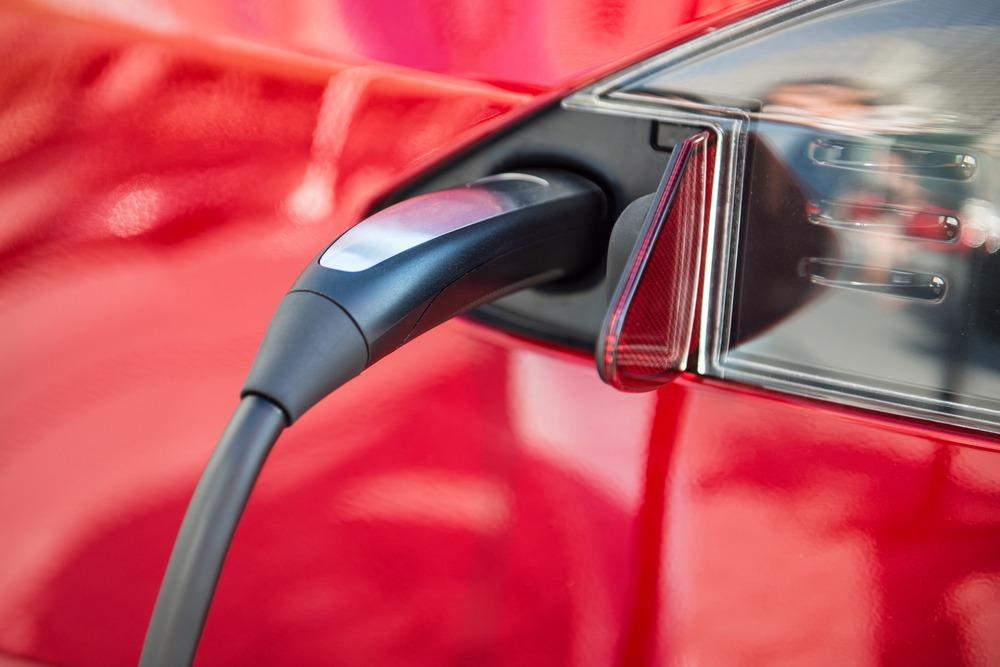
Image Credit: Nick Starichenko/Shutterstock.com
Governments worldwide have pledged to stop the manufacturing of petrol and diesel vehicles to reduce harmful emissions and improve air quality. UK Prime Minister Boris Johnson intends to ban the sale of such cars by 2030, followed by hybrid vehicles by 2035. The USA, Japan, and China also have similar agendas.
Electric vehicles (EVs), powered by huge batteries, will take their place. There are already more than 10 million EVs on the road worldwide, but to meet these ambitious targets, millions more zero-emission vehicles must be developed and manufactured.
Range Anxiety Versus Added Weight
Adopting EVs must happen more rapidly, but consumers are hesitant due to ‘range anxiety’. The distance a vehicle travels on a single charge varies between 250 to 400 miles, but the lack of infrastructure such as charging stations prevents a wider uptake.
Improving battery performance could increase the range and add more weight to the battery, which already accounts for up to 35% of the vehicle’s overall mass. Consequently, car manufacturers favor new technology to boost vehicle performance and reduce their environmental impact, including finding cost-effective, lighter-weight materials and more sustainable production methods.
Reducing Weight with Composites
Lightweight composite materials such as fiber-reinforced plastic polymer composites are vital to the next generation of EVs' success. They can reduce the weight of EVs, helping to increase the range performance and lifespan of the vehicle, while also improving its environmental credentials.
The Tucana Project from Jaguar Land Rover is a four-year plan aimed at positioning the UK as a leader in low-carbon technology. Its goal is to stimulate the mainstream adoption of EVs by developing a fleet with advanced lightweight composites that deliver increased range and greater performance, while also preventing 4.5 million tons of carbon dioxide emissions between 2023 to 2032.
Aluminum and steel structures will be replaced with composites designed to give a 30% improvement in vehicle stiffness while decreasing the weight by 35 kg. The composites will also be capable of handling the increased torque generated by high-performance batteries, leading to an overall improvement in efficiency.
The strategic use of tailored composites, such as carbon fiber, will help refine crash safety while allowing for larger batteries with an increased range. Fewer tailpipe emissions and a decrease in energy consumption of electrified powertrains will also reduce carbon dioxide emissions.
“The development of new lightweight body structures to complement the latest zero-emissions powertrains will be key as the electrification of our vehicle range continues,” explains Marcus Henry, research manager at Jaguar Land Rover.
“This project will allow the true environmental credentials of electric vehicles to be realized by enabling wider adoption of the technology and will propel Jaguar Land Rover and the UK supply chain into a world-leading position in low-carbon technology.”
Other car manufacturers are following suit: Volkswagen aims to increase their offering of fully electric vehicles from 20 to 70 by 2030, while General Motors plans to have a fleet of 30 EV models by 2025.
More than a Weight Reduction
Composites are essential to the next generation of EVs. Not only do they enable manufacturers to reduce the mass of the battery, composites can also reduce the weight of other parts of the car by consolidation, in addition to offering multifunctional integration, for example, by embedding sensors and wires.
They are also quicker and cheaper to design, reducing the number of parts required and tooling costs, say researchers from the RISE Research Institutes of Sweden, the University of Applied Sciences & Art of South Switzerland, and the Slovak University of Technology, who are building on the experience of space and aircraft industries, to adapt composites for use in the automotive industry.
Composites can easily be integrated into existing production lines using ‘patching’ – the straightforward switch of a part made with steel to one made of composites - and are more cost-effective.
They can also be made into complex shapes, and offer desirable characteristics, such as adding torsional stiffness to the body. In some cases, composites are the only suitable material that meets fire, thermal and electrical requirements of battery enclosures, for example.
Conclusion
Composites are critical to the future development of EVs. They allow manufacturers to reduce the overall mass of the vehicle, and therefore energy consumption and carbon dioxide emissions, with the added benefit of also increasing lifespan. Since the production costs for EVs have not yet been fully optimised, composites offer the opportunity to simplify the process and make it more efficient.
References and Further Reading
SpecialChem, (2021) Jaguar Land Rover’s New Project to Test Lightweight Composites in Electric Vehicles, Omnexus [online] https://omnexus.specialchem.com/news/industry-news/jaguar-project-lightweight-composites-000223824. Accessed 28 February 2021.
European Institute of Innovation and Technology, (2020) Lightweight composite materials: the key to the next generation of electric vehicles, eit [online] https://eit.europa.eu/news-events/news/lightweight-composite-materials-key-next-generation-electric-vehicles. Accessed 28 February 2021.
Brosius, D. (2020) What is the role of composites in electric vehicles? Composites World [online] https://www.compositesworld.com/articles/what-is-the-role-of-composites-in-electric-vehicles. Accessed 28 February 2021.
Shanahan, J. (2021) There are now more than 10 million electric vehicles on the road, Zap Map [online] https://www.zap-map.com/there-are-now-more-than-10-million-electric-vehicles-on-the-road/. Accessed 28 February 2021.
Disclaimer: The views expressed here are those of the author expressed in their private capacity and do not necessarily represent the views of AZoM.com Limited T/A AZoNetwork the owner and operator of this website. This disclaimer forms part of the Terms and conditions of use of this website.